Organisational Behaviour: Influence of Culture, Politics, Power, Motivation, and Teamwork on Performance
VerifiedAdded on 2023/06/07
|13
|4699
|382
AI Summary
This resource explores how an organisation's culture, politics, power, motivation, and teamwork impact individual and team behaviour and performance. It analyses Asda's organisational system and suggests reward concepts to increase output. The resource evaluates motivational theories and techniques for effective goal achievement and explains what makes an effective team. It also discusses how to apply organisational behaviour concepts in a business situation.
Contribute Materials
Your contribution can guide someone’s learning journey. Share your
documents today.
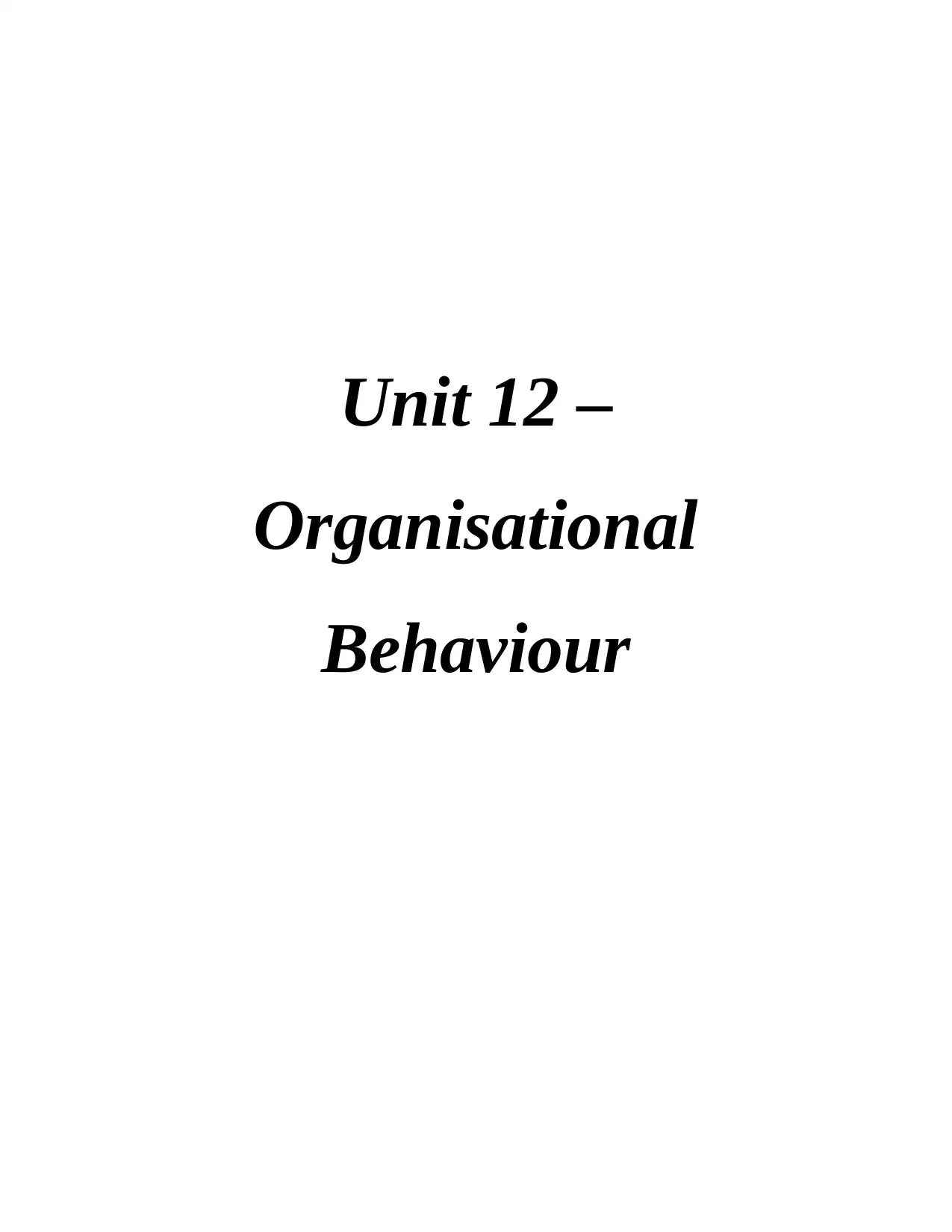
Unit 12 –
Organisational
Behaviour
Organisational
Behaviour
Secure Best Marks with AI Grader
Need help grading? Try our AI Grader for instant feedback on your assignments.
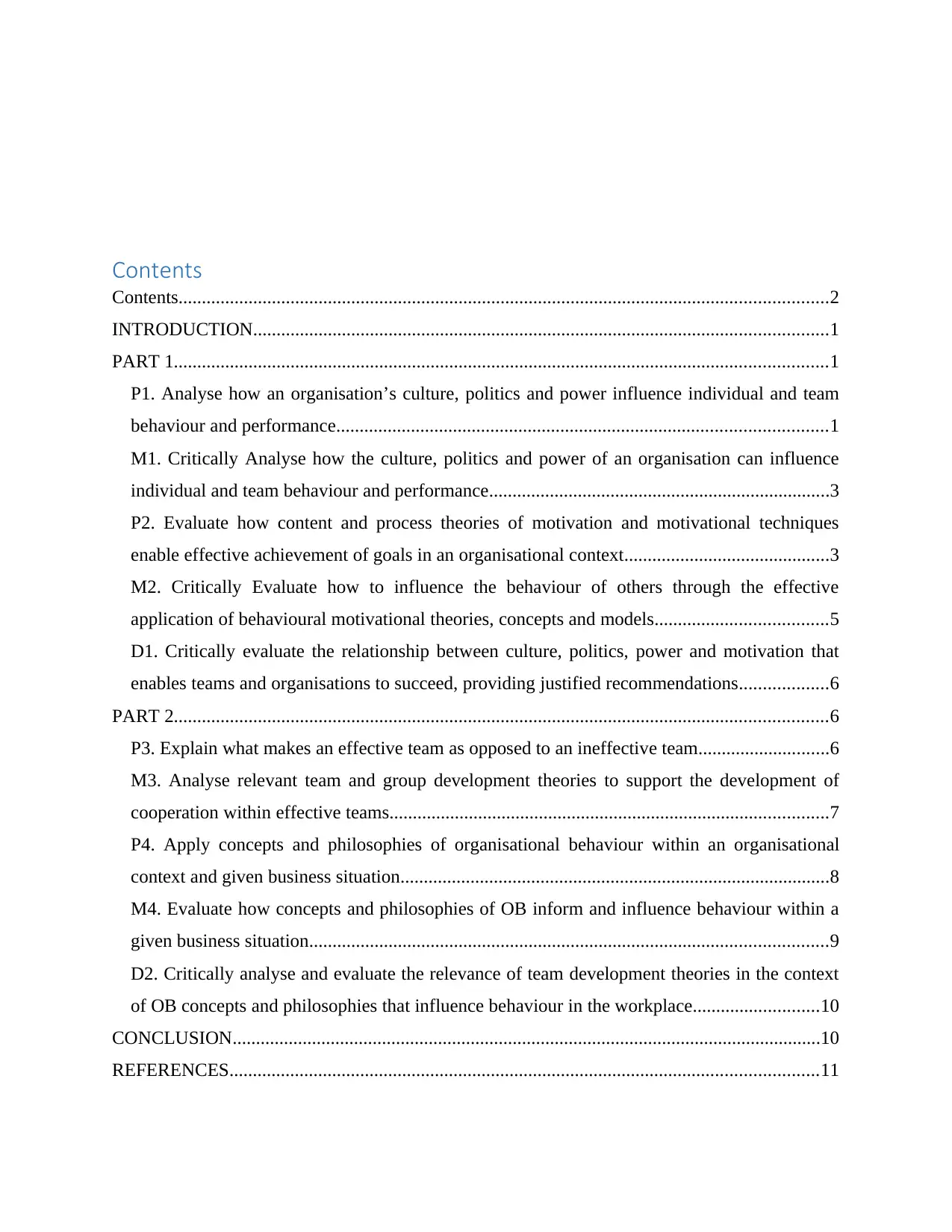
Contents
Contents...........................................................................................................................................2
INTRODUCTION...........................................................................................................................1
PART 1............................................................................................................................................1
P1. Analyse how an organisation’s culture, politics and power influence individual and team
behaviour and performance.........................................................................................................1
M1. Critically Analyse how the culture, politics and power of an organisation can influence
individual and team behaviour and performance.........................................................................3
P2. Evaluate how content and process theories of motivation and motivational techniques
enable effective achievement of goals in an organisational context............................................3
M2. Critically Evaluate how to influence the behaviour of others through the effective
application of behavioural motivational theories, concepts and models.....................................5
D1. Critically evaluate the relationship between culture, politics, power and motivation that
enables teams and organisations to succeed, providing justified recommendations...................6
PART 2............................................................................................................................................6
P3. Explain what makes an effective team as opposed to an ineffective team............................6
M3. Analyse relevant team and group development theories to support the development of
cooperation within effective teams..............................................................................................7
P4. Apply concepts and philosophies of organisational behaviour within an organisational
context and given business situation............................................................................................8
M4. Evaluate how concepts and philosophies of OB inform and influence behaviour within a
given business situation...............................................................................................................9
D2. Critically analyse and evaluate the relevance of team development theories in the context
of OB concepts and philosophies that influence behaviour in the workplace...........................10
CONCLUSION..............................................................................................................................10
REFERENCES..............................................................................................................................11
Contents...........................................................................................................................................2
INTRODUCTION...........................................................................................................................1
PART 1............................................................................................................................................1
P1. Analyse how an organisation’s culture, politics and power influence individual and team
behaviour and performance.........................................................................................................1
M1. Critically Analyse how the culture, politics and power of an organisation can influence
individual and team behaviour and performance.........................................................................3
P2. Evaluate how content and process theories of motivation and motivational techniques
enable effective achievement of goals in an organisational context............................................3
M2. Critically Evaluate how to influence the behaviour of others through the effective
application of behavioural motivational theories, concepts and models.....................................5
D1. Critically evaluate the relationship between culture, politics, power and motivation that
enables teams and organisations to succeed, providing justified recommendations...................6
PART 2............................................................................................................................................6
P3. Explain what makes an effective team as opposed to an ineffective team............................6
M3. Analyse relevant team and group development theories to support the development of
cooperation within effective teams..............................................................................................7
P4. Apply concepts and philosophies of organisational behaviour within an organisational
context and given business situation............................................................................................8
M4. Evaluate how concepts and philosophies of OB inform and influence behaviour within a
given business situation...............................................................................................................9
D2. Critically analyse and evaluate the relevance of team development theories in the context
of OB concepts and philosophies that influence behaviour in the workplace...........................10
CONCLUSION..............................................................................................................................10
REFERENCES..............................................................................................................................11
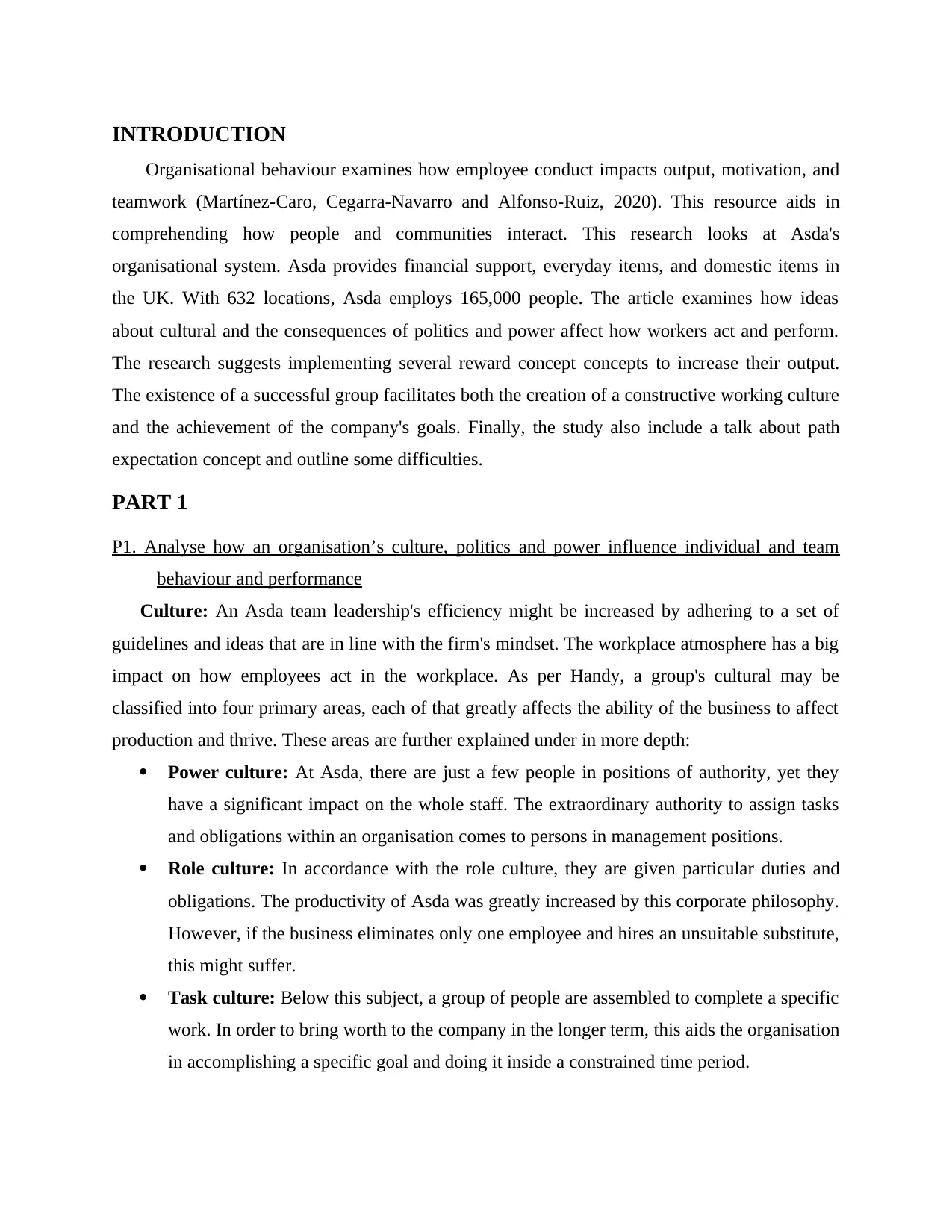
INTRODUCTION
Organisational behaviour examines how employee conduct impacts output, motivation, and
teamwork (Martínez-Caro, Cegarra-Navarro and Alfonso-Ruiz, 2020). This resource aids in
comprehending how people and communities interact. This research looks at Asda's
organisational system. Asda provides financial support, everyday items, and domestic items in
the UK. With 632 locations, Asda employs 165,000 people. The article examines how ideas
about cultural and the consequences of politics and power affect how workers act and perform.
The research suggests implementing several reward concept concepts to increase their output.
The existence of a successful group facilitates both the creation of a constructive working culture
and the achievement of the company's goals. Finally, the study also include a talk about path
expectation concept and outline some difficulties.
PART 1
P1. Analyse how an organisation’s culture, politics and power influence individual and team
behaviour and performance
Culture: An Asda team leadership's efficiency might be increased by adhering to a set of
guidelines and ideas that are in line with the firm's mindset. The workplace atmosphere has a big
impact on how employees act in the workplace. As per Handy, a group's cultural may be
classified into four primary areas, each of that greatly affects the ability of the business to affect
production and thrive. These areas are further explained under in more depth:
Power culture: At Asda, there are just a few people in positions of authority, yet they
have a significant impact on the whole staff. The extraordinary authority to assign tasks
and obligations within an organisation comes to persons in management positions.
Role culture: In accordance with the role culture, they are given particular duties and
obligations. The productivity of Asda was greatly increased by this corporate philosophy.
However, if the business eliminates only one employee and hires an unsuitable substitute,
this might suffer.
Task culture: Below this subject, a group of people are assembled to complete a specific
work. In order to bring worth to the company in the longer term, this aids the organisation
in accomplishing a specific goal and doing it inside a constrained time period.
Organisational behaviour examines how employee conduct impacts output, motivation, and
teamwork (Martínez-Caro, Cegarra-Navarro and Alfonso-Ruiz, 2020). This resource aids in
comprehending how people and communities interact. This research looks at Asda's
organisational system. Asda provides financial support, everyday items, and domestic items in
the UK. With 632 locations, Asda employs 165,000 people. The article examines how ideas
about cultural and the consequences of politics and power affect how workers act and perform.
The research suggests implementing several reward concept concepts to increase their output.
The existence of a successful group facilitates both the creation of a constructive working culture
and the achievement of the company's goals. Finally, the study also include a talk about path
expectation concept and outline some difficulties.
PART 1
P1. Analyse how an organisation’s culture, politics and power influence individual and team
behaviour and performance
Culture: An Asda team leadership's efficiency might be increased by adhering to a set of
guidelines and ideas that are in line with the firm's mindset. The workplace atmosphere has a big
impact on how employees act in the workplace. As per Handy, a group's cultural may be
classified into four primary areas, each of that greatly affects the ability of the business to affect
production and thrive. These areas are further explained under in more depth:
Power culture: At Asda, there are just a few people in positions of authority, yet they
have a significant impact on the whole staff. The extraordinary authority to assign tasks
and obligations within an organisation comes to persons in management positions.
Role culture: In accordance with the role culture, they are given particular duties and
obligations. The productivity of Asda was greatly increased by this corporate philosophy.
However, if the business eliminates only one employee and hires an unsuitable substitute,
this might suffer.
Task culture: Below this subject, a group of people are assembled to complete a specific
work. In order to bring worth to the company in the longer term, this aids the organisation
in accomplishing a specific goal and doing it inside a constrained time period.
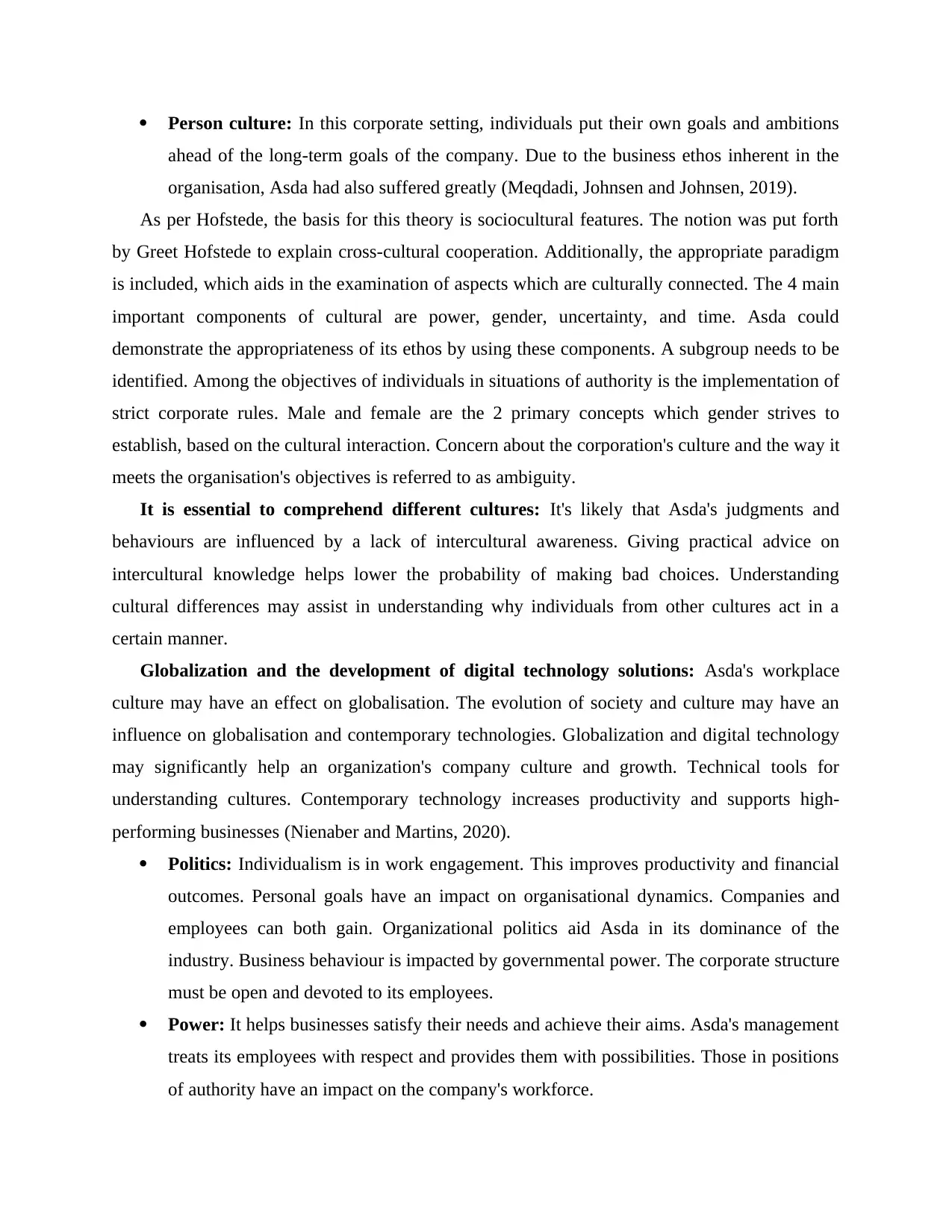
Person culture: In this corporate setting, individuals put their own goals and ambitions
ahead of the long-term goals of the company. Due to the business ethos inherent in the
organisation, Asda had also suffered greatly (Meqdadi, Johnsen and Johnsen, 2019).
As per Hofstede, the basis for this theory is sociocultural features. The notion was put forth
by Greet Hofstede to explain cross-cultural cooperation. Additionally, the appropriate paradigm
is included, which aids in the examination of aspects which are culturally connected. The 4 main
important components of cultural are power, gender, uncertainty, and time. Asda could
demonstrate the appropriateness of its ethos by using these components. A subgroup needs to be
identified. Among the objectives of individuals in situations of authority is the implementation of
strict corporate rules. Male and female are the 2 primary concepts which gender strives to
establish, based on the cultural interaction. Concern about the corporation's culture and the way it
meets the organisation's objectives is referred to as ambiguity.
It is essential to comprehend different cultures: It's likely that Asda's judgments and
behaviours are influenced by a lack of intercultural awareness. Giving practical advice on
intercultural knowledge helps lower the probability of making bad choices. Understanding
cultural differences may assist in understanding why individuals from other cultures act in a
certain manner.
Globalization and the development of digital technology solutions: Asda's workplace
culture may have an effect on globalisation. The evolution of society and culture may have an
influence on globalisation and contemporary technologies. Globalization and digital technology
may significantly help an organization's company culture and growth. Technical tools for
understanding cultures. Contemporary technology increases productivity and supports high-
performing businesses (Nienaber and Martins, 2020).
Politics: Individualism is in work engagement. This improves productivity and financial
outcomes. Personal goals have an impact on organisational dynamics. Companies and
employees can both gain. Organizational politics aid Asda in its dominance of the
industry. Business behaviour is impacted by governmental power. The corporate structure
must be open and devoted to its employees.
Power: It helps businesses satisfy their needs and achieve their aims. Asda's management
treats its employees with respect and provides them with possibilities. Those in positions
of authority have an impact on the company's workforce.
ahead of the long-term goals of the company. Due to the business ethos inherent in the
organisation, Asda had also suffered greatly (Meqdadi, Johnsen and Johnsen, 2019).
As per Hofstede, the basis for this theory is sociocultural features. The notion was put forth
by Greet Hofstede to explain cross-cultural cooperation. Additionally, the appropriate paradigm
is included, which aids in the examination of aspects which are culturally connected. The 4 main
important components of cultural are power, gender, uncertainty, and time. Asda could
demonstrate the appropriateness of its ethos by using these components. A subgroup needs to be
identified. Among the objectives of individuals in situations of authority is the implementation of
strict corporate rules. Male and female are the 2 primary concepts which gender strives to
establish, based on the cultural interaction. Concern about the corporation's culture and the way it
meets the organisation's objectives is referred to as ambiguity.
It is essential to comprehend different cultures: It's likely that Asda's judgments and
behaviours are influenced by a lack of intercultural awareness. Giving practical advice on
intercultural knowledge helps lower the probability of making bad choices. Understanding
cultural differences may assist in understanding why individuals from other cultures act in a
certain manner.
Globalization and the development of digital technology solutions: Asda's workplace
culture may have an effect on globalisation. The evolution of society and culture may have an
influence on globalisation and contemporary technologies. Globalization and digital technology
may significantly help an organization's company culture and growth. Technical tools for
understanding cultures. Contemporary technology increases productivity and supports high-
performing businesses (Nienaber and Martins, 2020).
Politics: Individualism is in work engagement. This improves productivity and financial
outcomes. Personal goals have an impact on organisational dynamics. Companies and
employees can both gain. Organizational politics aid Asda in its dominance of the
industry. Business behaviour is impacted by governmental power. The corporate structure
must be open and devoted to its employees.
Power: It helps businesses satisfy their needs and achieve their aims. Asda's management
treats its employees with respect and provides them with possibilities. Those in positions
of authority have an impact on the company's workforce.
Secure Best Marks with AI Grader
Need help grading? Try our AI Grader for instant feedback on your assignments.
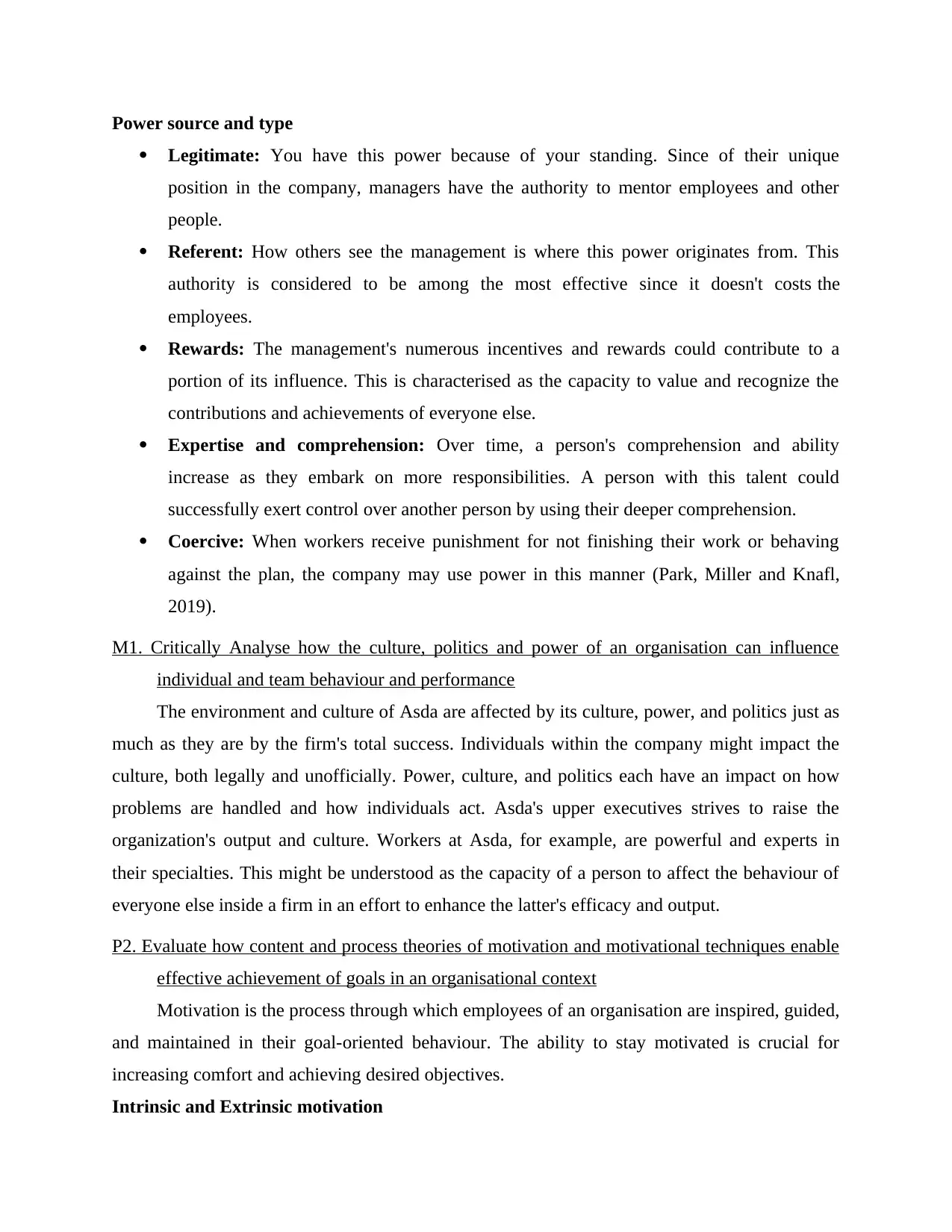
Power source and type
Legitimate: You have this power because of your standing. Since of their unique
position in the company, managers have the authority to mentor employees and other
people.
Referent: How others see the management is where this power originates from. This
authority is considered to be among the most effective since it doesn't costs the
employees.
Rewards: The management's numerous incentives and rewards could contribute to a
portion of its influence. This is characterised as the capacity to value and recognize the
contributions and achievements of everyone else.
Expertise and comprehension: Over time, a person's comprehension and ability
increase as they embark on more responsibilities. A person with this talent could
successfully exert control over another person by using their deeper comprehension.
Coercive: When workers receive punishment for not finishing their work or behaving
against the plan, the company may use power in this manner (Park, Miller and Knafl,
2019).
M1. Critically Analyse how the culture, politics and power of an organisation can influence
individual and team behaviour and performance
The environment and culture of Asda are affected by its culture, power, and politics just as
much as they are by the firm's total success. Individuals within the company might impact the
culture, both legally and unofficially. Power, culture, and politics each have an impact on how
problems are handled and how individuals act. Asda's upper executives strives to raise the
organization's output and culture. Workers at Asda, for example, are powerful and experts in
their specialties. This might be understood as the capacity of a person to affect the behaviour of
everyone else inside a firm in an effort to enhance the latter's efficacy and output.
P2. Evaluate how content and process theories of motivation and motivational techniques enable
effective achievement of goals in an organisational context
Motivation is the process through which employees of an organisation are inspired, guided,
and maintained in their goal-oriented behaviour. The ability to stay motivated is crucial for
increasing comfort and achieving desired objectives.
Intrinsic and Extrinsic motivation
Legitimate: You have this power because of your standing. Since of their unique
position in the company, managers have the authority to mentor employees and other
people.
Referent: How others see the management is where this power originates from. This
authority is considered to be among the most effective since it doesn't costs the
employees.
Rewards: The management's numerous incentives and rewards could contribute to a
portion of its influence. This is characterised as the capacity to value and recognize the
contributions and achievements of everyone else.
Expertise and comprehension: Over time, a person's comprehension and ability
increase as they embark on more responsibilities. A person with this talent could
successfully exert control over another person by using their deeper comprehension.
Coercive: When workers receive punishment for not finishing their work or behaving
against the plan, the company may use power in this manner (Park, Miller and Knafl,
2019).
M1. Critically Analyse how the culture, politics and power of an organisation can influence
individual and team behaviour and performance
The environment and culture of Asda are affected by its culture, power, and politics just as
much as they are by the firm's total success. Individuals within the company might impact the
culture, both legally and unofficially. Power, culture, and politics each have an impact on how
problems are handled and how individuals act. Asda's upper executives strives to raise the
organization's output and culture. Workers at Asda, for example, are powerful and experts in
their specialties. This might be understood as the capacity of a person to affect the behaviour of
everyone else inside a firm in an effort to enhance the latter's efficacy and output.
P2. Evaluate how content and process theories of motivation and motivational techniques enable
effective achievement of goals in an organisational context
Motivation is the process through which employees of an organisation are inspired, guided,
and maintained in their goal-oriented behaviour. The ability to stay motivated is crucial for
increasing comfort and achieving desired objectives.
Intrinsic and Extrinsic motivation
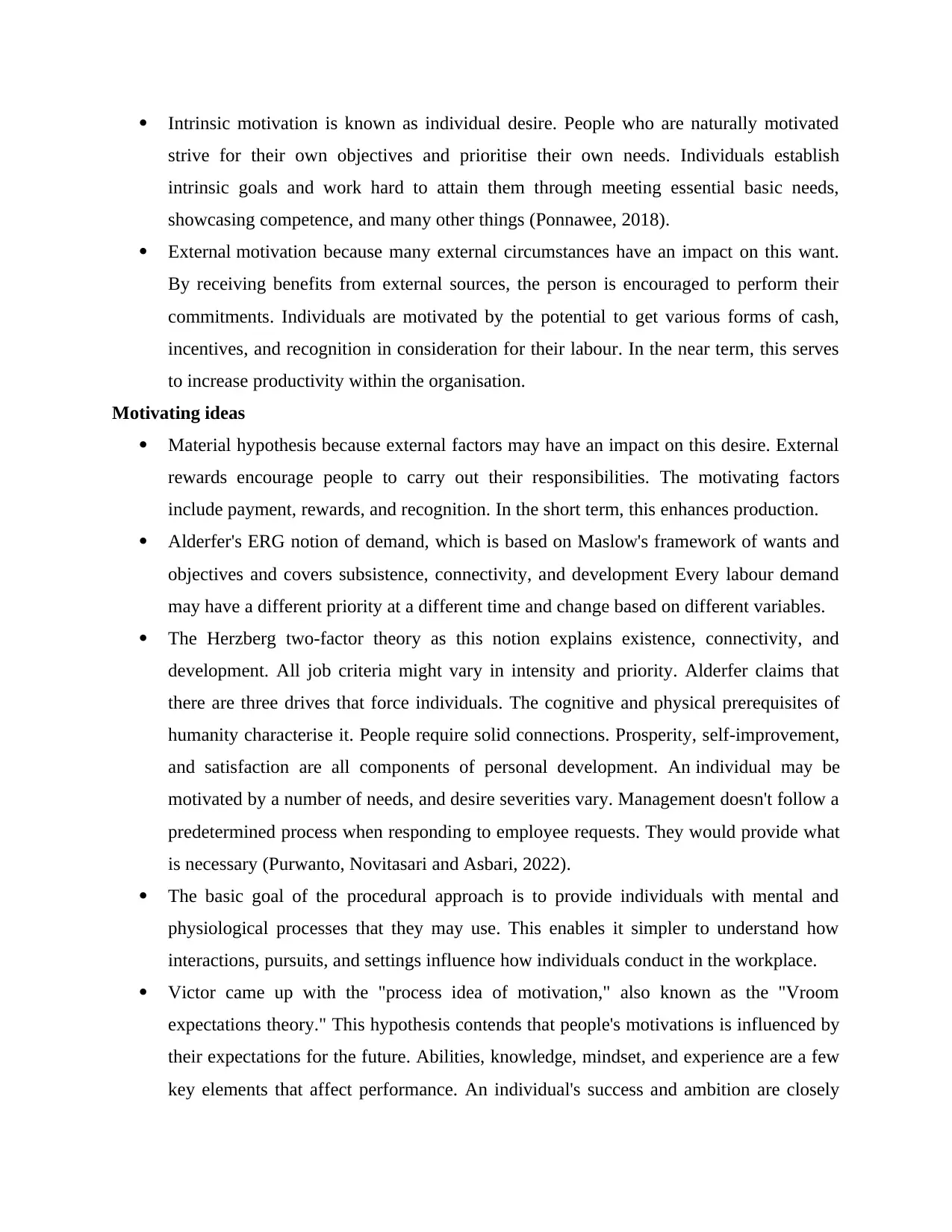
Intrinsic motivation is known as individual desire. People who are naturally motivated
strive for their own objectives and prioritise their own needs. Individuals establish
intrinsic goals and work hard to attain them through meeting essential basic needs,
showcasing competence, and many other things (Ponnawee, 2018).
External motivation because many external circumstances have an impact on this want.
By receiving benefits from external sources, the person is encouraged to perform their
commitments. Individuals are motivated by the potential to get various forms of cash,
incentives, and recognition in consideration for their labour. In the near term, this serves
to increase productivity within the organisation.
Motivating ideas
Material hypothesis because external factors may have an impact on this desire. External
rewards encourage people to carry out their responsibilities. The motivating factors
include payment, rewards, and recognition. In the short term, this enhances production.
Alderfer's ERG notion of demand, which is based on Maslow's framework of wants and
objectives and covers subsistence, connectivity, and development Every labour demand
may have a different priority at a different time and change based on different variables.
The Herzberg two-factor theory as this notion explains existence, connectivity, and
development. All job criteria might vary in intensity and priority. Alderfer claims that
there are three drives that force individuals. The cognitive and physical prerequisites of
humanity characterise it. People require solid connections. Prosperity, self-improvement,
and satisfaction are all components of personal development. An individual may be
motivated by a number of needs, and desire severities vary. Management doesn't follow a
predetermined process when responding to employee requests. They would provide what
is necessary (Purwanto, Novitasari and Asbari, 2022).
The basic goal of the procedural approach is to provide individuals with mental and
physiological processes that they may use. This enables it simpler to understand how
interactions, pursuits, and settings influence how individuals conduct in the workplace.
Victor came up with the "process idea of motivation," also known as the "Vroom
expectations theory." This hypothesis contends that people's motivations is influenced by
their expectations for the future. Abilities, knowledge, mindset, and experience are a few
key elements that affect performance. An individual's success and ambition are closely
strive for their own objectives and prioritise their own needs. Individuals establish
intrinsic goals and work hard to attain them through meeting essential basic needs,
showcasing competence, and many other things (Ponnawee, 2018).
External motivation because many external circumstances have an impact on this want.
By receiving benefits from external sources, the person is encouraged to perform their
commitments. Individuals are motivated by the potential to get various forms of cash,
incentives, and recognition in consideration for their labour. In the near term, this serves
to increase productivity within the organisation.
Motivating ideas
Material hypothesis because external factors may have an impact on this desire. External
rewards encourage people to carry out their responsibilities. The motivating factors
include payment, rewards, and recognition. In the short term, this enhances production.
Alderfer's ERG notion of demand, which is based on Maslow's framework of wants and
objectives and covers subsistence, connectivity, and development Every labour demand
may have a different priority at a different time and change based on different variables.
The Herzberg two-factor theory as this notion explains existence, connectivity, and
development. All job criteria might vary in intensity and priority. Alderfer claims that
there are three drives that force individuals. The cognitive and physical prerequisites of
humanity characterise it. People require solid connections. Prosperity, self-improvement,
and satisfaction are all components of personal development. An individual may be
motivated by a number of needs, and desire severities vary. Management doesn't follow a
predetermined process when responding to employee requests. They would provide what
is necessary (Purwanto, Novitasari and Asbari, 2022).
The basic goal of the procedural approach is to provide individuals with mental and
physiological processes that they may use. This enables it simpler to understand how
interactions, pursuits, and settings influence how individuals conduct in the workplace.
Victor came up with the "process idea of motivation," also known as the "Vroom
expectations theory." This hypothesis contends that people's motivations is influenced by
their expectations for the future. Abilities, knowledge, mindset, and experience are a few
key elements that affect performance. An individual's success and ambition are closely
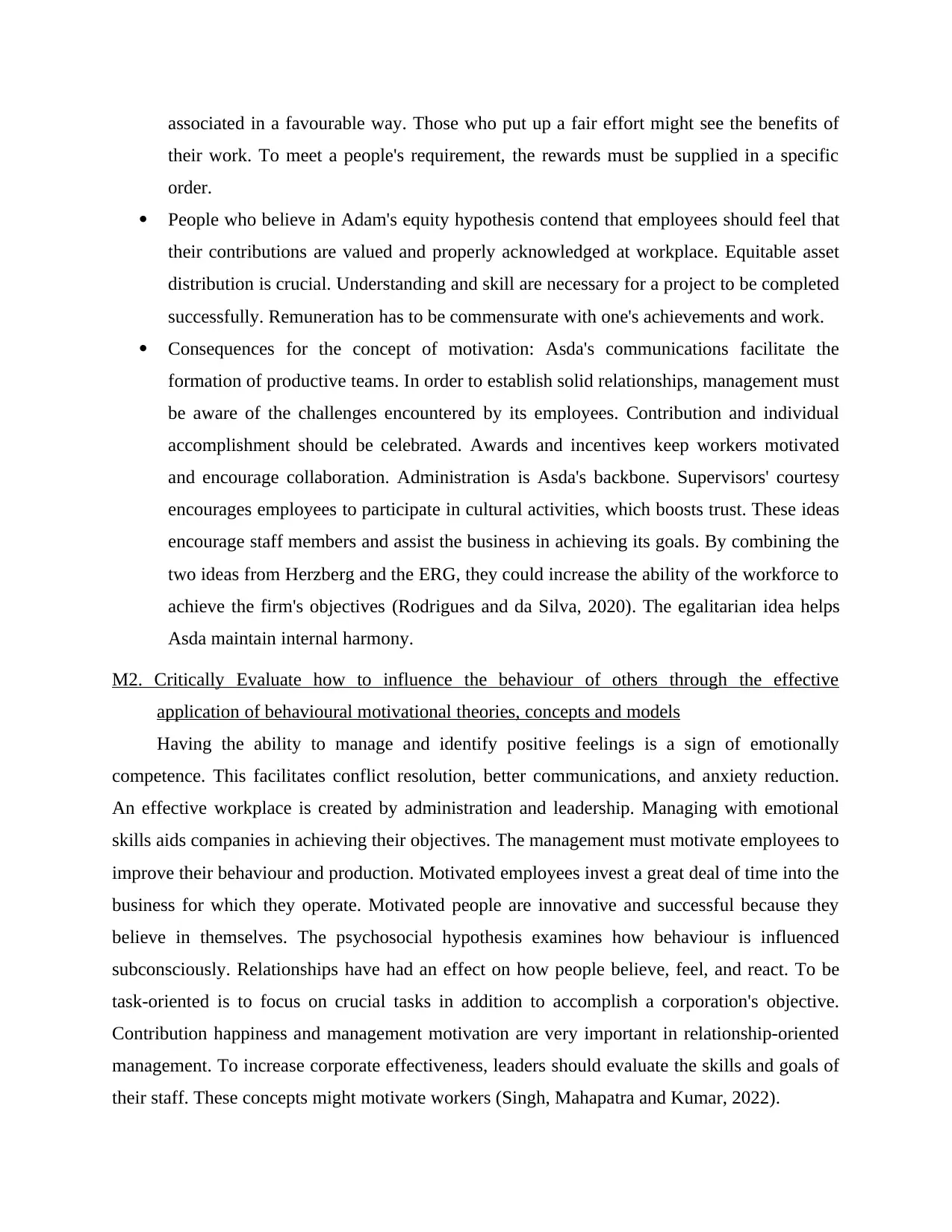
associated in a favourable way. Those who put up a fair effort might see the benefits of
their work. To meet a people's requirement, the rewards must be supplied in a specific
order.
People who believe in Adam's equity hypothesis contend that employees should feel that
their contributions are valued and properly acknowledged at workplace. Equitable asset
distribution is crucial. Understanding and skill are necessary for a project to be completed
successfully. Remuneration has to be commensurate with one's achievements and work.
Consequences for the concept of motivation: Asda's communications facilitate the
formation of productive teams. In order to establish solid relationships, management must
be aware of the challenges encountered by its employees. Contribution and individual
accomplishment should be celebrated. Awards and incentives keep workers motivated
and encourage collaboration. Administration is Asda's backbone. Supervisors' courtesy
encourages employees to participate in cultural activities, which boosts trust. These ideas
encourage staff members and assist the business in achieving its goals. By combining the
two ideas from Herzberg and the ERG, they could increase the ability of the workforce to
achieve the firm's objectives (Rodrigues and da Silva, 2020). The egalitarian idea helps
Asda maintain internal harmony.
M2. Critically Evaluate how to influence the behaviour of others through the effective
application of behavioural motivational theories, concepts and models
Having the ability to manage and identify positive feelings is a sign of emotionally
competence. This facilitates conflict resolution, better communications, and anxiety reduction.
An effective workplace is created by administration and leadership. Managing with emotional
skills aids companies in achieving their objectives. The management must motivate employees to
improve their behaviour and production. Motivated employees invest a great deal of time into the
business for which they operate. Motivated people are innovative and successful because they
believe in themselves. The psychosocial hypothesis examines how behaviour is influenced
subconsciously. Relationships have had an effect on how people believe, feel, and react. To be
task-oriented is to focus on crucial tasks in addition to accomplish a corporation's objective.
Contribution happiness and management motivation are very important in relationship-oriented
management. To increase corporate effectiveness, leaders should evaluate the skills and goals of
their staff. These concepts might motivate workers (Singh, Mahapatra and Kumar, 2022).
their work. To meet a people's requirement, the rewards must be supplied in a specific
order.
People who believe in Adam's equity hypothesis contend that employees should feel that
their contributions are valued and properly acknowledged at workplace. Equitable asset
distribution is crucial. Understanding and skill are necessary for a project to be completed
successfully. Remuneration has to be commensurate with one's achievements and work.
Consequences for the concept of motivation: Asda's communications facilitate the
formation of productive teams. In order to establish solid relationships, management must
be aware of the challenges encountered by its employees. Contribution and individual
accomplishment should be celebrated. Awards and incentives keep workers motivated
and encourage collaboration. Administration is Asda's backbone. Supervisors' courtesy
encourages employees to participate in cultural activities, which boosts trust. These ideas
encourage staff members and assist the business in achieving its goals. By combining the
two ideas from Herzberg and the ERG, they could increase the ability of the workforce to
achieve the firm's objectives (Rodrigues and da Silva, 2020). The egalitarian idea helps
Asda maintain internal harmony.
M2. Critically Evaluate how to influence the behaviour of others through the effective
application of behavioural motivational theories, concepts and models
Having the ability to manage and identify positive feelings is a sign of emotionally
competence. This facilitates conflict resolution, better communications, and anxiety reduction.
An effective workplace is created by administration and leadership. Managing with emotional
skills aids companies in achieving their objectives. The management must motivate employees to
improve their behaviour and production. Motivated employees invest a great deal of time into the
business for which they operate. Motivated people are innovative and successful because they
believe in themselves. The psychosocial hypothesis examines how behaviour is influenced
subconsciously. Relationships have had an effect on how people believe, feel, and react. To be
task-oriented is to focus on crucial tasks in addition to accomplish a corporation's objective.
Contribution happiness and management motivation are very important in relationship-oriented
management. To increase corporate effectiveness, leaders should evaluate the skills and goals of
their staff. These concepts might motivate workers (Singh, Mahapatra and Kumar, 2022).
Paraphrase This Document
Need a fresh take? Get an instant paraphrase of this document with our AI Paraphraser
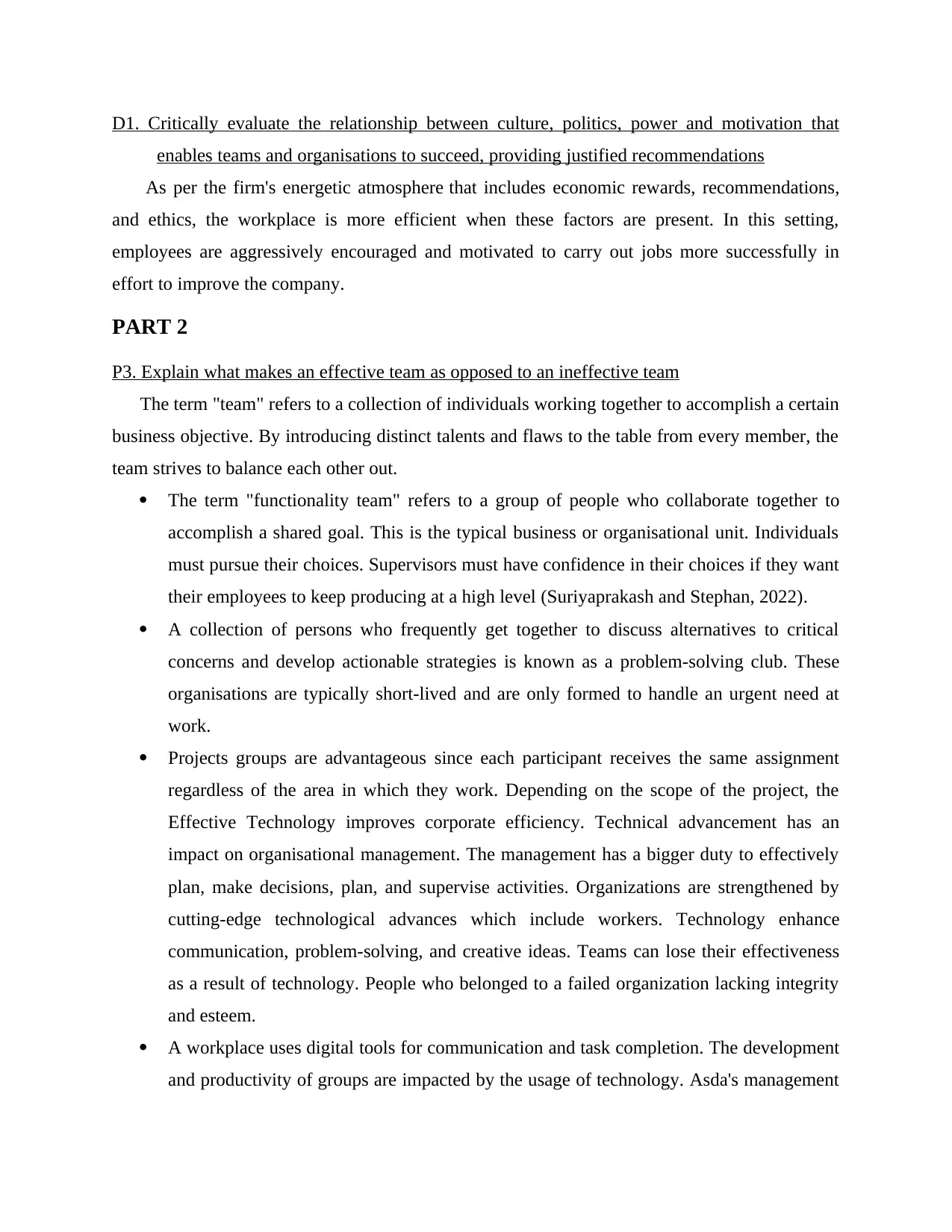
D1. Critically evaluate the relationship between culture, politics, power and motivation that
enables teams and organisations to succeed, providing justified recommendations
As per the firm's energetic atmosphere that includes economic rewards, recommendations,
and ethics, the workplace is more efficient when these factors are present. In this setting,
employees are aggressively encouraged and motivated to carry out jobs more successfully in
effort to improve the company.
PART 2
P3. Explain what makes an effective team as opposed to an ineffective team
The term "team" refers to a collection of individuals working together to accomplish a certain
business objective. By introducing distinct talents and flaws to the table from every member, the
team strives to balance each other out.
The term "functionality team" refers to a group of people who collaborate together to
accomplish a shared goal. This is the typical business or organisational unit. Individuals
must pursue their choices. Supervisors must have confidence in their choices if they want
their employees to keep producing at a high level (Suriyaprakash and Stephan, 2022).
A collection of persons who frequently get together to discuss alternatives to critical
concerns and develop actionable strategies is known as a problem-solving club. These
organisations are typically short-lived and are only formed to handle an urgent need at
work.
Projects groups are advantageous since each participant receives the same assignment
regardless of the area in which they work. Depending on the scope of the project, the
Effective Technology improves corporate efficiency. Technical advancement has an
impact on organisational management. The management has a bigger duty to effectively
plan, make decisions, plan, and supervise activities. Organizations are strengthened by
cutting-edge technological advances which include workers. Technology enhance
communication, problem-solving, and creative ideas. Teams can lose their effectiveness
as a result of technology. People who belonged to a failed organization lacking integrity
and esteem.
A workplace uses digital tools for communication and task completion. The development
and productivity of groups are impacted by the usage of technology. Asda's management
enables teams and organisations to succeed, providing justified recommendations
As per the firm's energetic atmosphere that includes economic rewards, recommendations,
and ethics, the workplace is more efficient when these factors are present. In this setting,
employees are aggressively encouraged and motivated to carry out jobs more successfully in
effort to improve the company.
PART 2
P3. Explain what makes an effective team as opposed to an ineffective team
The term "team" refers to a collection of individuals working together to accomplish a certain
business objective. By introducing distinct talents and flaws to the table from every member, the
team strives to balance each other out.
The term "functionality team" refers to a group of people who collaborate together to
accomplish a shared goal. This is the typical business or organisational unit. Individuals
must pursue their choices. Supervisors must have confidence in their choices if they want
their employees to keep producing at a high level (Suriyaprakash and Stephan, 2022).
A collection of persons who frequently get together to discuss alternatives to critical
concerns and develop actionable strategies is known as a problem-solving club. These
organisations are typically short-lived and are only formed to handle an urgent need at
work.
Projects groups are advantageous since each participant receives the same assignment
regardless of the area in which they work. Depending on the scope of the project, the
Effective Technology improves corporate efficiency. Technical advancement has an
impact on organisational management. The management has a bigger duty to effectively
plan, make decisions, plan, and supervise activities. Organizations are strengthened by
cutting-edge technological advances which include workers. Technology enhance
communication, problem-solving, and creative ideas. Teams can lose their effectiveness
as a result of technology. People who belonged to a failed organization lacking integrity
and esteem.
A workplace uses digital tools for communication and task completion. The development
and productivity of groups are impacted by the usage of technology. Asda's management
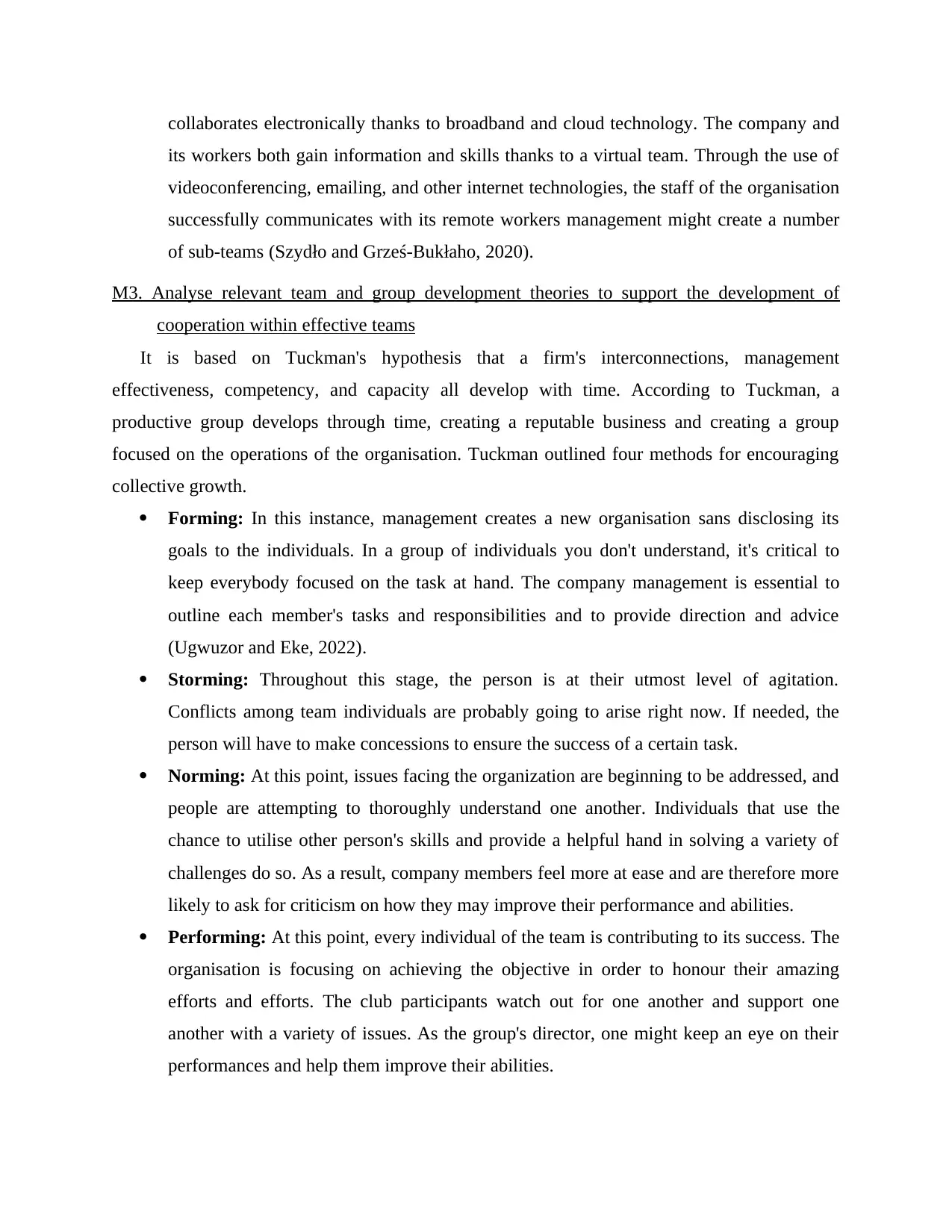
collaborates electronically thanks to broadband and cloud technology. The company and
its workers both gain information and skills thanks to a virtual team. Through the use of
videoconferencing, emailing, and other internet technologies, the staff of the organisation
successfully communicates with its remote workers management might create a number
of sub-teams (Szydło and Grześ-Bukłaho, 2020).
M3. Analyse relevant team and group development theories to support the development of
cooperation within effective teams
It is based on Tuckman's hypothesis that a firm's interconnections, management
effectiveness, competency, and capacity all develop with time. According to Tuckman, a
productive group develops through time, creating a reputable business and creating a group
focused on the operations of the organisation. Tuckman outlined four methods for encouraging
collective growth.
Forming: In this instance, management creates a new organisation sans disclosing its
goals to the individuals. In a group of individuals you don't understand, it's critical to
keep everybody focused on the task at hand. The company management is essential to
outline each member's tasks and responsibilities and to provide direction and advice
(Ugwuzor and Eke, 2022).
Storming: Throughout this stage, the person is at their utmost level of agitation.
Conflicts among team individuals are probably going to arise right now. If needed, the
person will have to make concessions to ensure the success of a certain task.
Norming: At this point, issues facing the organization are beginning to be addressed, and
people are attempting to thoroughly understand one another. Individuals that use the
chance to utilise other person's skills and provide a helpful hand in solving a variety of
challenges do so. As a result, company members feel more at ease and are therefore more
likely to ask for criticism on how they may improve their performance and abilities.
Performing: At this point, every individual of the team is contributing to its success. The
organisation is focusing on achieving the objective in order to honour their amazing
efforts and efforts. The club participants watch out for one another and support one
another with a variety of issues. As the group's director, one might keep an eye on their
performances and help them improve their abilities.
its workers both gain information and skills thanks to a virtual team. Through the use of
videoconferencing, emailing, and other internet technologies, the staff of the organisation
successfully communicates with its remote workers management might create a number
of sub-teams (Szydło and Grześ-Bukłaho, 2020).
M3. Analyse relevant team and group development theories to support the development of
cooperation within effective teams
It is based on Tuckman's hypothesis that a firm's interconnections, management
effectiveness, competency, and capacity all develop with time. According to Tuckman, a
productive group develops through time, creating a reputable business and creating a group
focused on the operations of the organisation. Tuckman outlined four methods for encouraging
collective growth.
Forming: In this instance, management creates a new organisation sans disclosing its
goals to the individuals. In a group of individuals you don't understand, it's critical to
keep everybody focused on the task at hand. The company management is essential to
outline each member's tasks and responsibilities and to provide direction and advice
(Ugwuzor and Eke, 2022).
Storming: Throughout this stage, the person is at their utmost level of agitation.
Conflicts among team individuals are probably going to arise right now. If needed, the
person will have to make concessions to ensure the success of a certain task.
Norming: At this point, issues facing the organization are beginning to be addressed, and
people are attempting to thoroughly understand one another. Individuals that use the
chance to utilise other person's skills and provide a helpful hand in solving a variety of
challenges do so. As a result, company members feel more at ease and are therefore more
likely to ask for criticism on how they may improve their performance and abilities.
Performing: At this point, every individual of the team is contributing to its success. The
organisation is focusing on achieving the objective in order to honour their amazing
efforts and efforts. The club participants watch out for one another and support one
another with a variety of issues. As the group's director, one might keep an eye on their
performances and help them improve their abilities.
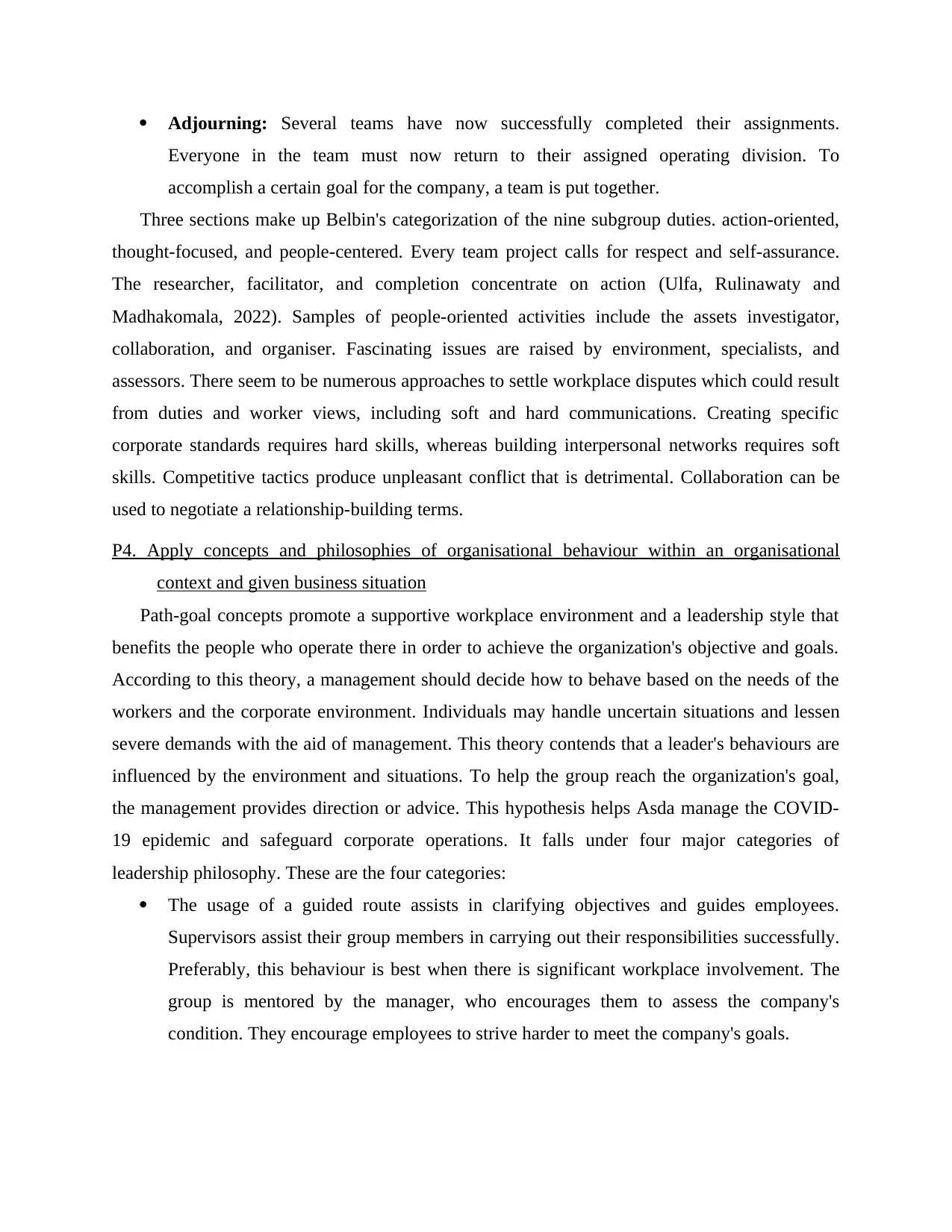
Adjourning: Several teams have now successfully completed their assignments.
Everyone in the team must now return to their assigned operating division. To
accomplish a certain goal for the company, a team is put together.
Three sections make up Belbin's categorization of the nine subgroup duties. action-oriented,
thought-focused, and people-centered. Every team project calls for respect and self-assurance.
The researcher, facilitator, and completion concentrate on action (Ulfa, Rulinawaty and
Madhakomala, 2022). Samples of people-oriented activities include the assets investigator,
collaboration, and organiser. Fascinating issues are raised by environment, specialists, and
assessors. There seem to be numerous approaches to settle workplace disputes which could result
from duties and worker views, including soft and hard communications. Creating specific
corporate standards requires hard skills, whereas building interpersonal networks requires soft
skills. Competitive tactics produce unpleasant conflict that is detrimental. Collaboration can be
used to negotiate a relationship-building terms.
P4. Apply concepts and philosophies of organisational behaviour within an organisational
context and given business situation
Path-goal concepts promote a supportive workplace environment and a leadership style that
benefits the people who operate there in order to achieve the organization's objective and goals.
According to this theory, a management should decide how to behave based on the needs of the
workers and the corporate environment. Individuals may handle uncertain situations and lessen
severe demands with the aid of management. This theory contends that a leader's behaviours are
influenced by the environment and situations. To help the group reach the organization's goal,
the management provides direction or advice. This hypothesis helps Asda manage the COVID-
19 epidemic and safeguard corporate operations. It falls under four major categories of
leadership philosophy. These are the four categories:
The usage of a guided route assists in clarifying objectives and guides employees.
Supervisors assist their group members in carrying out their responsibilities successfully.
Preferably, this behaviour is best when there is significant workplace involvement. The
group is mentored by the manager, who encourages them to assess the company's
condition. They encourage employees to strive harder to meet the company's goals.
Everyone in the team must now return to their assigned operating division. To
accomplish a certain goal for the company, a team is put together.
Three sections make up Belbin's categorization of the nine subgroup duties. action-oriented,
thought-focused, and people-centered. Every team project calls for respect and self-assurance.
The researcher, facilitator, and completion concentrate on action (Ulfa, Rulinawaty and
Madhakomala, 2022). Samples of people-oriented activities include the assets investigator,
collaboration, and organiser. Fascinating issues are raised by environment, specialists, and
assessors. There seem to be numerous approaches to settle workplace disputes which could result
from duties and worker views, including soft and hard communications. Creating specific
corporate standards requires hard skills, whereas building interpersonal networks requires soft
skills. Competitive tactics produce unpleasant conflict that is detrimental. Collaboration can be
used to negotiate a relationship-building terms.
P4. Apply concepts and philosophies of organisational behaviour within an organisational
context and given business situation
Path-goal concepts promote a supportive workplace environment and a leadership style that
benefits the people who operate there in order to achieve the organization's objective and goals.
According to this theory, a management should decide how to behave based on the needs of the
workers and the corporate environment. Individuals may handle uncertain situations and lessen
severe demands with the aid of management. This theory contends that a leader's behaviours are
influenced by the environment and situations. To help the group reach the organization's goal,
the management provides direction or advice. This hypothesis helps Asda manage the COVID-
19 epidemic and safeguard corporate operations. It falls under four major categories of
leadership philosophy. These are the four categories:
The usage of a guided route assists in clarifying objectives and guides employees.
Supervisors assist their group members in carrying out their responsibilities successfully.
Preferably, this behaviour is best when there is significant workplace involvement. The
group is mentored by the manager, who encourages them to assess the company's
condition. They encourage employees to strive harder to meet the company's goals.
Secure Best Marks with AI Grader
Need help grading? Try our AI Grader for instant feedback on your assignments.
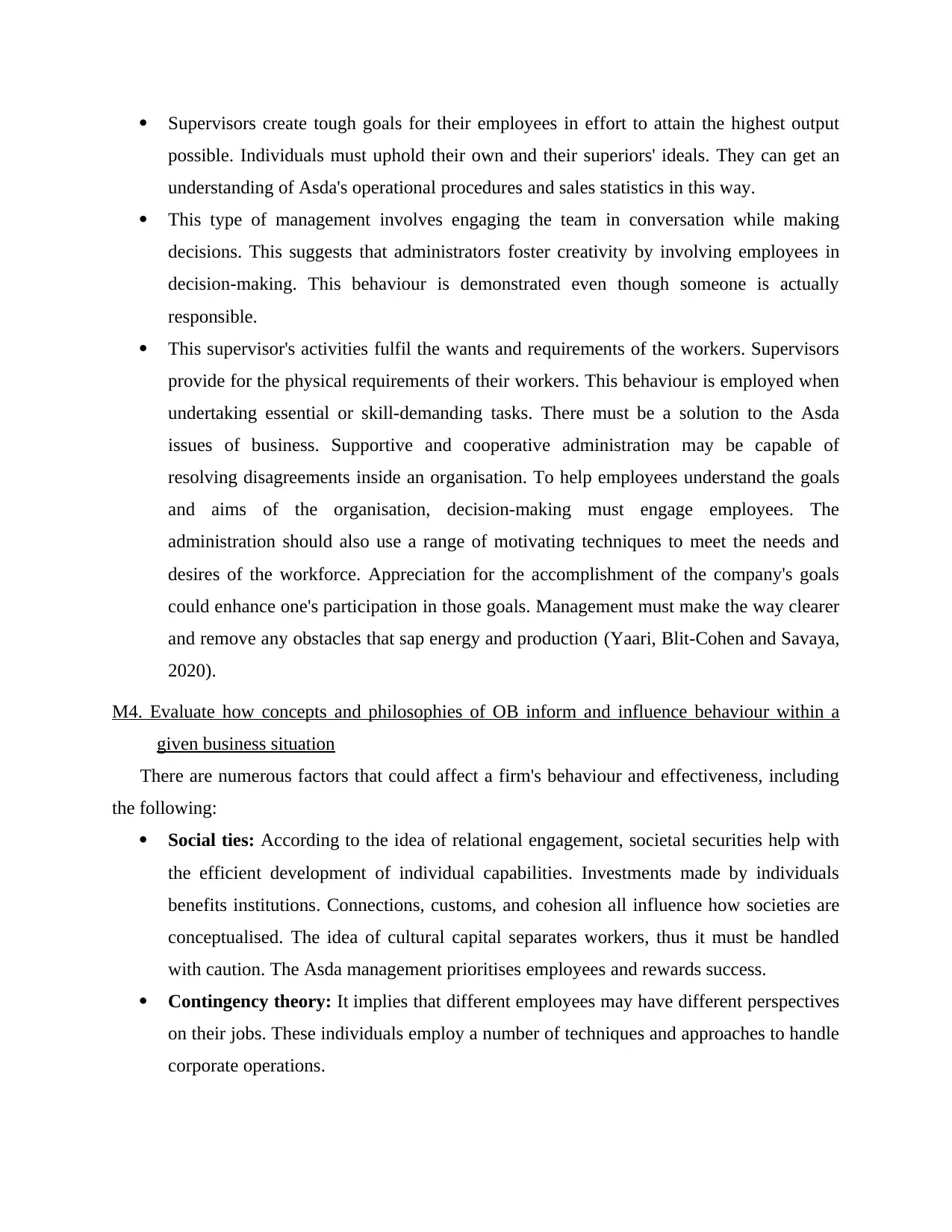
Supervisors create tough goals for their employees in effort to attain the highest output
possible. Individuals must uphold their own and their superiors' ideals. They can get an
understanding of Asda's operational procedures and sales statistics in this way.
This type of management involves engaging the team in conversation while making
decisions. This suggests that administrators foster creativity by involving employees in
decision-making. This behaviour is demonstrated even though someone is actually
responsible.
This supervisor's activities fulfil the wants and requirements of the workers. Supervisors
provide for the physical requirements of their workers. This behaviour is employed when
undertaking essential or skill-demanding tasks. There must be a solution to the Asda
issues of business. Supportive and cooperative administration may be capable of
resolving disagreements inside an organisation. To help employees understand the goals
and aims of the organisation, decision-making must engage employees. The
administration should also use a range of motivating techniques to meet the needs and
desires of the workforce. Appreciation for the accomplishment of the company's goals
could enhance one's participation in those goals. Management must make the way clearer
and remove any obstacles that sap energy and production (Yaari, Blit-Cohen and Savaya,
2020).
M4. Evaluate how concepts and philosophies of OB inform and influence behaviour within a
given business situation
There are numerous factors that could affect a firm's behaviour and effectiveness, including
the following:
Social ties: According to the idea of relational engagement, societal securities help with
the efficient development of individual capabilities. Investments made by individuals
benefits institutions. Connections, customs, and cohesion all influence how societies are
conceptualised. The idea of cultural capital separates workers, thus it must be handled
with caution. The Asda management prioritises employees and rewards success.
Contingency theory: It implies that different employees may have different perspectives
on their jobs. These individuals employ a number of techniques and approaches to handle
corporate operations.
possible. Individuals must uphold their own and their superiors' ideals. They can get an
understanding of Asda's operational procedures and sales statistics in this way.
This type of management involves engaging the team in conversation while making
decisions. This suggests that administrators foster creativity by involving employees in
decision-making. This behaviour is demonstrated even though someone is actually
responsible.
This supervisor's activities fulfil the wants and requirements of the workers. Supervisors
provide for the physical requirements of their workers. This behaviour is employed when
undertaking essential or skill-demanding tasks. There must be a solution to the Asda
issues of business. Supportive and cooperative administration may be capable of
resolving disagreements inside an organisation. To help employees understand the goals
and aims of the organisation, decision-making must engage employees. The
administration should also use a range of motivating techniques to meet the needs and
desires of the workforce. Appreciation for the accomplishment of the company's goals
could enhance one's participation in those goals. Management must make the way clearer
and remove any obstacles that sap energy and production (Yaari, Blit-Cohen and Savaya,
2020).
M4. Evaluate how concepts and philosophies of OB inform and influence behaviour within a
given business situation
There are numerous factors that could affect a firm's behaviour and effectiveness, including
the following:
Social ties: According to the idea of relational engagement, societal securities help with
the efficient development of individual capabilities. Investments made by individuals
benefits institutions. Connections, customs, and cohesion all influence how societies are
conceptualised. The idea of cultural capital separates workers, thus it must be handled
with caution. The Asda management prioritises employees and rewards success.
Contingency theory: It implies that different employees may have different perspectives
on their jobs. These individuals employ a number of techniques and approaches to handle
corporate operations.
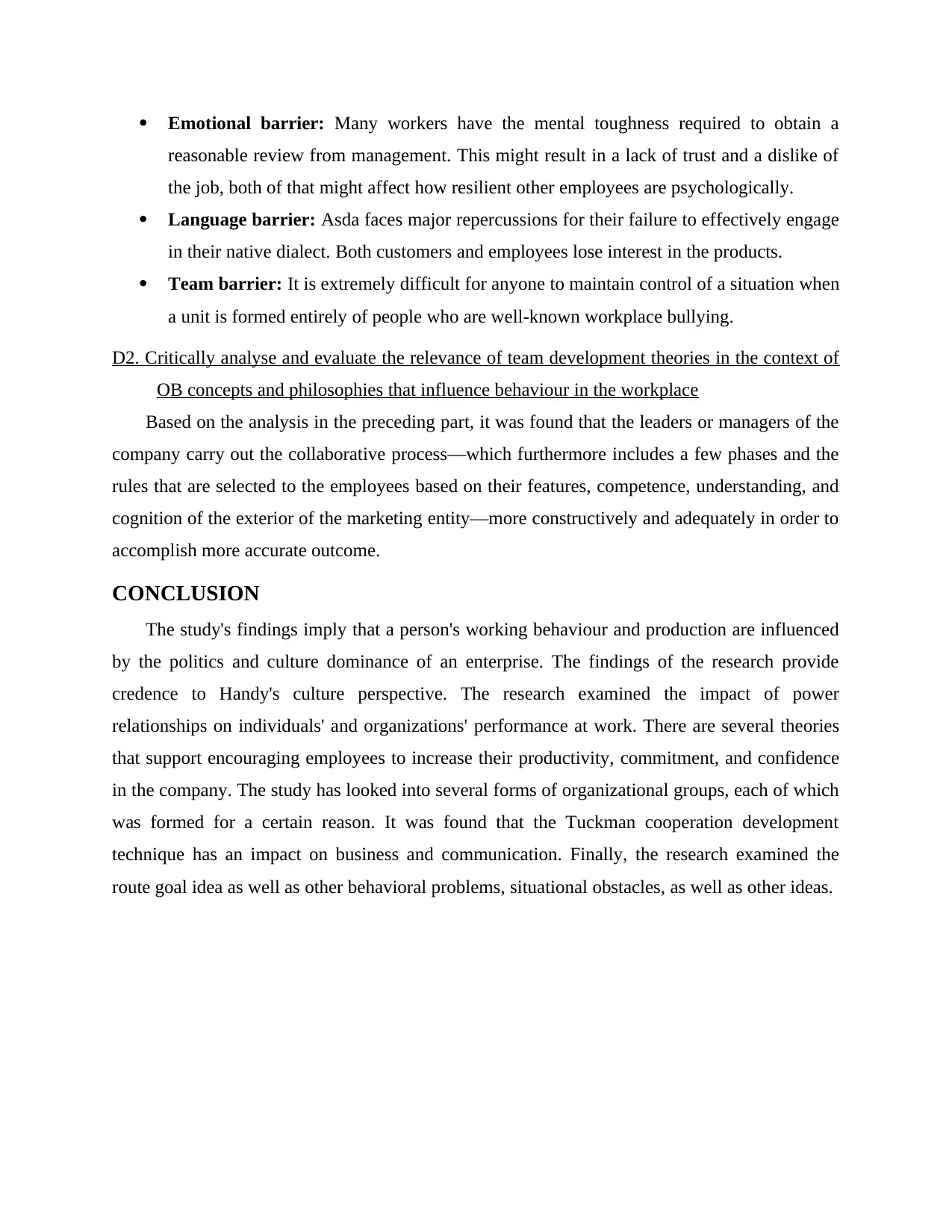
Emotional barrier: Many workers have the mental toughness required to obtain a
reasonable review from management. This might result in a lack of trust and a dislike of
the job, both of that might affect how resilient other employees are psychologically.
Language barrier: Asda faces major repercussions for their failure to effectively engage
in their native dialect. Both customers and employees lose interest in the products.
Team barrier: It is extremely difficult for anyone to maintain control of a situation when
a unit is formed entirely of people who are well-known workplace bullying.
D2. Critically analyse and evaluate the relevance of team development theories in the context of
OB concepts and philosophies that influence behaviour in the workplace
Based on the analysis in the preceding part, it was found that the leaders or managers of the
company carry out the collaborative process—which furthermore includes a few phases and the
rules that are selected to the employees based on their features, competence, understanding, and
cognition of the exterior of the marketing entity—more constructively and adequately in order to
accomplish more accurate outcome.
CONCLUSION
The study's findings imply that a person's working behaviour and production are influenced
by the politics and culture dominance of an enterprise. The findings of the research provide
credence to Handy's culture perspective. The research examined the impact of power
relationships on individuals' and organizations' performance at work. There are several theories
that support encouraging employees to increase their productivity, commitment, and confidence
in the company. The study has looked into several forms of organizational groups, each of which
was formed for a certain reason. It was found that the Tuckman cooperation development
technique has an impact on business and communication. Finally, the research examined the
route goal idea as well as other behavioral problems, situational obstacles, as well as other ideas.
reasonable review from management. This might result in a lack of trust and a dislike of
the job, both of that might affect how resilient other employees are psychologically.
Language barrier: Asda faces major repercussions for their failure to effectively engage
in their native dialect. Both customers and employees lose interest in the products.
Team barrier: It is extremely difficult for anyone to maintain control of a situation when
a unit is formed entirely of people who are well-known workplace bullying.
D2. Critically analyse and evaluate the relevance of team development theories in the context of
OB concepts and philosophies that influence behaviour in the workplace
Based on the analysis in the preceding part, it was found that the leaders or managers of the
company carry out the collaborative process—which furthermore includes a few phases and the
rules that are selected to the employees based on their features, competence, understanding, and
cognition of the exterior of the marketing entity—more constructively and adequately in order to
accomplish more accurate outcome.
CONCLUSION
The study's findings imply that a person's working behaviour and production are influenced
by the politics and culture dominance of an enterprise. The findings of the research provide
credence to Handy's culture perspective. The research examined the impact of power
relationships on individuals' and organizations' performance at work. There are several theories
that support encouraging employees to increase their productivity, commitment, and confidence
in the company. The study has looked into several forms of organizational groups, each of which
was formed for a certain reason. It was found that the Tuckman cooperation development
technique has an impact on business and communication. Finally, the research examined the
route goal idea as well as other behavioral problems, situational obstacles, as well as other ideas.
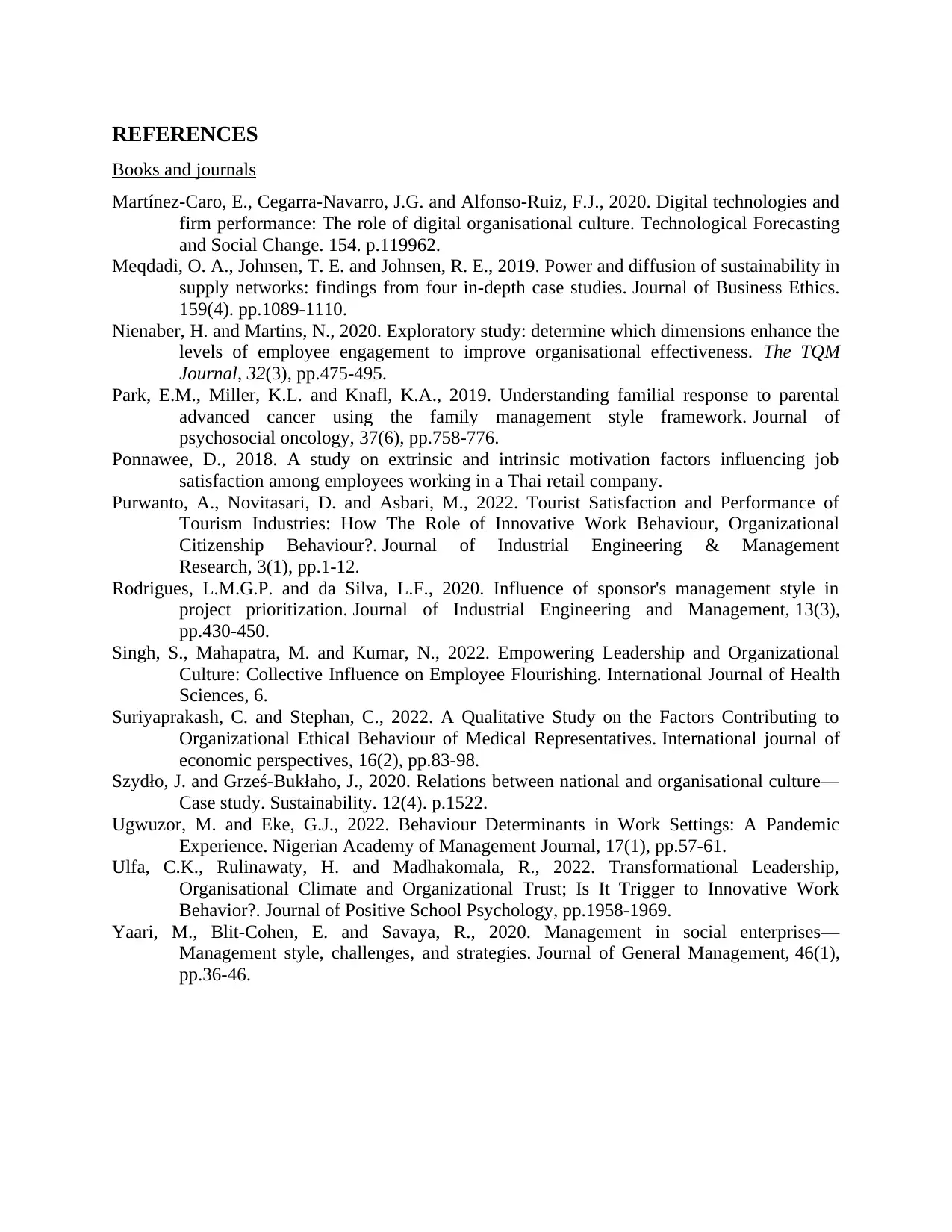
REFERENCES
Books and journals
Martínez-Caro, E., Cegarra-Navarro, J.G. and Alfonso-Ruiz, F.J., 2020. Digital technologies and
firm performance: The role of digital organisational culture. Technological Forecasting
and Social Change. 154. p.119962.
Meqdadi, O. A., Johnsen, T. E. and Johnsen, R. E., 2019. Power and diffusion of sustainability in
supply networks: findings from four in-depth case studies. Journal of Business Ethics.
159(4). pp.1089-1110.
Nienaber, H. and Martins, N., 2020. Exploratory study: determine which dimensions enhance the
levels of employee engagement to improve organisational effectiveness. The TQM
Journal, 32(3), pp.475-495.
Park, E.M., Miller, K.L. and Knafl, K.A., 2019. Understanding familial response to parental
advanced cancer using the family management style framework. Journal of
psychosocial oncology, 37(6), pp.758-776.
Ponnawee, D., 2018. A study on extrinsic and intrinsic motivation factors influencing job
satisfaction among employees working in a Thai retail company.
Purwanto, A., Novitasari, D. and Asbari, M., 2022. Tourist Satisfaction and Performance of
Tourism Industries: How The Role of Innovative Work Behaviour, Organizational
Citizenship Behaviour?. Journal of Industrial Engineering & Management
Research, 3(1), pp.1-12.
Rodrigues, L.M.G.P. and da Silva, L.F., 2020. Influence of sponsor's management style in
project prioritization. Journal of Industrial Engineering and Management, 13(3),
pp.430-450.
Singh, S., Mahapatra, M. and Kumar, N., 2022. Empowering Leadership and Organizational
Culture: Collective Influence on Employee Flourishing. International Journal of Health
Sciences, 6.
Suriyaprakash, C. and Stephan, C., 2022. A Qualitative Study on the Factors Contributing to
Organizational Ethical Behaviour of Medical Representatives. International journal of
economic perspectives, 16(2), pp.83-98.
Szydło, J. and Grześ-Bukłaho, J., 2020. Relations between national and organisational culture—
Case study. Sustainability. 12(4). p.1522.
Ugwuzor, M. and Eke, G.J., 2022. Behaviour Determinants in Work Settings: A Pandemic
Experience. Nigerian Academy of Management Journal, 17(1), pp.57-61.
Ulfa, C.K., Rulinawaty, H. and Madhakomala, R., 2022. Transformational Leadership,
Organisational Climate and Organizational Trust; Is It Trigger to Innovative Work
Behavior?. Journal of Positive School Psychology, pp.1958-1969.
Yaari, M., Blit-Cohen, E. and Savaya, R., 2020. Management in social enterprises—
Management style, challenges, and strategies. Journal of General Management, 46(1),
pp.36-46.
Books and journals
Martínez-Caro, E., Cegarra-Navarro, J.G. and Alfonso-Ruiz, F.J., 2020. Digital technologies and
firm performance: The role of digital organisational culture. Technological Forecasting
and Social Change. 154. p.119962.
Meqdadi, O. A., Johnsen, T. E. and Johnsen, R. E., 2019. Power and diffusion of sustainability in
supply networks: findings from four in-depth case studies. Journal of Business Ethics.
159(4). pp.1089-1110.
Nienaber, H. and Martins, N., 2020. Exploratory study: determine which dimensions enhance the
levels of employee engagement to improve organisational effectiveness. The TQM
Journal, 32(3), pp.475-495.
Park, E.M., Miller, K.L. and Knafl, K.A., 2019. Understanding familial response to parental
advanced cancer using the family management style framework. Journal of
psychosocial oncology, 37(6), pp.758-776.
Ponnawee, D., 2018. A study on extrinsic and intrinsic motivation factors influencing job
satisfaction among employees working in a Thai retail company.
Purwanto, A., Novitasari, D. and Asbari, M., 2022. Tourist Satisfaction and Performance of
Tourism Industries: How The Role of Innovative Work Behaviour, Organizational
Citizenship Behaviour?. Journal of Industrial Engineering & Management
Research, 3(1), pp.1-12.
Rodrigues, L.M.G.P. and da Silva, L.F., 2020. Influence of sponsor's management style in
project prioritization. Journal of Industrial Engineering and Management, 13(3),
pp.430-450.
Singh, S., Mahapatra, M. and Kumar, N., 2022. Empowering Leadership and Organizational
Culture: Collective Influence on Employee Flourishing. International Journal of Health
Sciences, 6.
Suriyaprakash, C. and Stephan, C., 2022. A Qualitative Study on the Factors Contributing to
Organizational Ethical Behaviour of Medical Representatives. International journal of
economic perspectives, 16(2), pp.83-98.
Szydło, J. and Grześ-Bukłaho, J., 2020. Relations between national and organisational culture—
Case study. Sustainability. 12(4). p.1522.
Ugwuzor, M. and Eke, G.J., 2022. Behaviour Determinants in Work Settings: A Pandemic
Experience. Nigerian Academy of Management Journal, 17(1), pp.57-61.
Ulfa, C.K., Rulinawaty, H. and Madhakomala, R., 2022. Transformational Leadership,
Organisational Climate and Organizational Trust; Is It Trigger to Innovative Work
Behavior?. Journal of Positive School Psychology, pp.1958-1969.
Yaari, M., Blit-Cohen, E. and Savaya, R., 2020. Management in social enterprises—
Management style, challenges, and strategies. Journal of General Management, 46(1),
pp.36-46.
1 out of 13
Related Documents
Your All-in-One AI-Powered Toolkit for Academic Success.
+13062052269
info@desklib.com
Available 24*7 on WhatsApp / Email
![[object Object]](/_next/static/media/star-bottom.7253800d.svg)
Unlock your academic potential
© 2024 | Zucol Services PVT LTD | All rights reserved.





